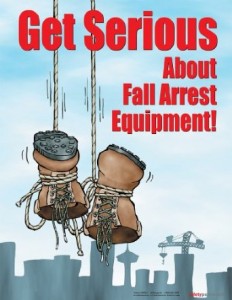
Alec Caldwell
Beware of fall protection gear packaged in buckets
Canadian ContractorSome big box stores carry buckets packed with a variety of fall protection items. Purchase them at your peril.
 Last week I watched a contractor walk out of a big box store carrying two fall protection systems in sealed buckets. When he gets round to opening them, he will find the following items: a temporary anchor, a lifeline, a rope grab, a lanyard (with shock absorber) and a full body harness.
Last week I watched a contractor walk out of a big box store carrying two fall protection systems in sealed buckets. When he gets round to opening them, he will find the following items: a temporary anchor, a lifeline, a rope grab, a lanyard (with shock absorber) and a full body harness.
Sounds great, right? All that safety gear in one cost-effective package? Sure, the price is right, but there’s a potentially devastating item included in that bucket: A false sense of security.
What’s wrong with this kind of merchandising? Well, let me compare it to the purchase of safety boots. What would you think if you went into a store and found that they only carried these boots in one size? Would that lead to good safety on the job site? Obviously, not. Well it’s the same with body harnesses; Bodies also come in different shapes and sizes and harnesses need to be sized to fit the wearer. If you wear the wrong size harness, it can be fatal, because you can be catapulted out of a poorly-fitting harness during a fall. So your safety harness is doing nothing but providing you with a false sense of security.
A group of CARAHS contractors inspected the “harness in a bucket” at our training facility in Pickering, Ont., last week. I made sure the harness was fitted tightly, especially the chest strap, and I adjusted the shoulder straps as best I could. But in our test, the harness did NOT stay in place. Both shoulder straps could easily be pulled downward off both my shoulders. Meaning, I could be ejected from the harness if I bounced around during a fall. We rated this particular harness as useless.
Choose a full body harness – and the rest of your fall safety system – carefully. Don’t buy based on convenience or price alone, as your life and your workers’ lives depends on quality gear. Select a harness that suits your specific body size.
Remember in Ontario, you cannot use fall protection systems unless you’ve completed the NEW Ministry of Labour Working at Heights standard training course – or you currently carry a Fall Training card and are using the current transition rules.
If you need information on the new MOL standards or are confused about transition rules, we have the answers. Call us toll free 1-866-366-2930.
By providing education and training, CARAHS reduces your risk of fines, job site closures and prosecution under the Ontario Occupational Health and Safety Act. We are independent of unions and government.
Featured online e-course WHMIS
Passion – Commitment – Integrity
Advertisement
Print this page


I have purchased several of the bucket kits. They are a great and convenient way to buy and stock the gear. A worse situation is not having any system, or piecing a system together and not getting it right. The harness is decent enough and offers good adjust-ability. The shock link and lanyard are good.
Of all the articles that this site releases this is probably the worst case of trying to create a story where one doesn’t exist. A better use of energy would have been to write an article on how to use fall protection and point to consider. But that would have taken time and thought. This site is better than this article.
Eye Roll, where did you buy your bucket kit. Rather than shoot down Alec for what he wrote, I’d like to make sure you guys are comparing the same products. Thanks for your post.
I understand you point, and somewhat agree, but I think it would be better to have one of these bucket kits, than not out of fear of getting the wrong thing. For the guys just starting out, they are a great way to at least have one, until the get educated enough to know what is out there and get what is best for them. I would much rather have a newbie on the site with one of these kits, than to have him “waiting” to have enough money to buy a so called “better” one, or using a borrowed old one from someone else, with a unknown condition.
You have to adjust all the straps to fit the wearer, and not change them when you get them right, I’ve never had one slip off, if it can, it is not fit to you right, and needs to be adjusted before use.
My first was one of these kits, I’ve had a few since. I now keep another “well stored” as a second for when my other one is “somewhere” else. It still gets used quit often. As to the “better” ones, I’ve they last about the same length of time, they can be little more comfortable, especially when squatting or on your knees, I think you all know what I mean…
Write a date on them when you buy them, inspect, (any one you buy) before every use. Any damage to any part, including UV (sun) degradation, fraying, cuts etc. do not use, and destroy the component before disposal so no one else can use it. I’ve found ropes last about three years if well taken care of. The longest I’ve managed to keep a harness was about four, but I was supervising more than working with that one. Use your own judgement, on the cautious side, you life depends on it. It does not take much of a fall to cause serious injury, one bump on the head from four feet could do it!
The only “complaint” I have about the kits … you always need more than one tie down, so always buy a few more, and many, many more fasteners.
Hi Eye,
I appreciate your feed back and I’ll address the lanyard you mentioned as being “good”
Here is an example, lets say a guy weighing 275lbs buys this off the shelf bucket, which includes a lanyard (with shock absorber) and its rated for someome who weighs a maximum 245lbs. Should this guy be using this lanyard. Would he be safe using this lanyard, especially if he took a fall. Would this lanyard save him.
The last time I checked, these buckets lanyards are only for someone weighing a maximum 245lbs. Please let us know if you find our differently.
I suggest everyone get a course under their belts on using fall systems beforehand. Some of these courses might on give the basics and some go into more depth.
Those living in Ontario from 1st April 1, must under law take a Working at Heights Standard course. This course covers all aspects of the equipment.
Last tip: Always read and follow manufactures instructions on every piece of equipement you buy. Reading the lanyard one I’m sure would give the maximum weight.
Good comment R Brennan and for your feed back.
Its better to have something than nothing for sure. Half a parachute might save us (then maybe not..right)
When we do a home renovation for a homeowner, we might give them options on the different quality of product. Explaining the difference.
With safety its should be the same, we need to know whats out there for sale and are they upto Canadain safety standards, like CSA or better.
Unfortunately sometimes systems in a bucket (from my experience) don’t meet safety standards.
Cheers
I have to agree with “Eye Roll” to some degree. The fact that you jump to a 245 max rating and use an example to a 275lb individual seems like you are trying too hard to support your case. I think most people are capable of reading, and heavy set individuals are very aware of their weight and fact that the world around them is geared toward the general population that fit the ideal BMI. The bucket kit my company has used as a staple van stocked fall protection safety system is sold by 3M and has the CSA Z259.1 certification the harness is rated for 310lbs. 3M 209510 Energy Absorbing Lanyard
Designed for up to a 6 foot free fall application for a single user with a maximum capacity up to 310 pounds (141 kg)
including clothing, tools, etc.
Snaphooks used on the 209510 marked with the ANSI Z359.1-07 or ANSI Z359.12-09 standard, are self-locking with a
minimal tensile break strength of 5,000 pounds and a 3,600 pound gate rating.
When dynamically tested in accordance with the requirements of the ANSI Z359.1-2007 standard, the 209510 has a maximum
arrest force of 900 lbf (4 kN) and a maximum elongation of 42 inches (1067 mm).
What most people do not know is the date life span, or the exposure that can shorten or end the product usability. People should inspecting their safety equipment twice. AFTER each use (allowing them ample time to get a replacement should issue be found. Before in case the equipment was used by others or suffered while being stored.
Better to promote the use of fall protection than write an article that may put people off purchasing it. The bucket kits are a great introduction for most people and provide a workable system at a reasonable dollar value. Anyone wanting the next level, or more specific gear can spend the extra money and time to research and piece it all together.
As a Working at Heights Instructor for a very large group of workers I have never followed the path they put in front of us. A lack of knowledge and understanding in the workplace is the biggest problem. Not knowing that all the equipment is and always has been size and weight rated can be fatal. I read the comment that said having something is better then nothing. No it is not!
I had a class of guys which half brought what they were given and had been using. Four of the six had E6 Lanyards and they were all under 160 lbs. They all had UAK harnesses, and could not put them on to where I could not pull it off in some fashion. The temporary anchor they were using is commonly used but wrong. Unfortunately at the end of the day workers are seen as just numbers and replaceable. That is a fact! There is equipment out there that could change the culture and make sure everyone makes it home, the problem is that it cost money and the laws on what needs to be provided need to change.
And when Working at Heights became mandatory, equipment prices skyrocketed, even the smallest, simplest piece that can be the difference between life and death comes with an inflated price tag. Training and education need to change, the laws that are supposed to protect workers need to change and more importantly the culture that the cost of equipment is weighted vs. a worker’s life. And most workers are unaware that it is “not” their responsibility to purchase the equipment; the employer is required to provide it.
Interesting article… there have been very few of them but it is pretty simple! If the companies have always had a size chart then obviously they are not one size fits all. Anyone providing equipment believing something is better then nothing should not be in a position to make those decisions.